Magellan Maestro 3150, MAESTRO 3100, Maestro 3050, Maestro 3140 User Manual
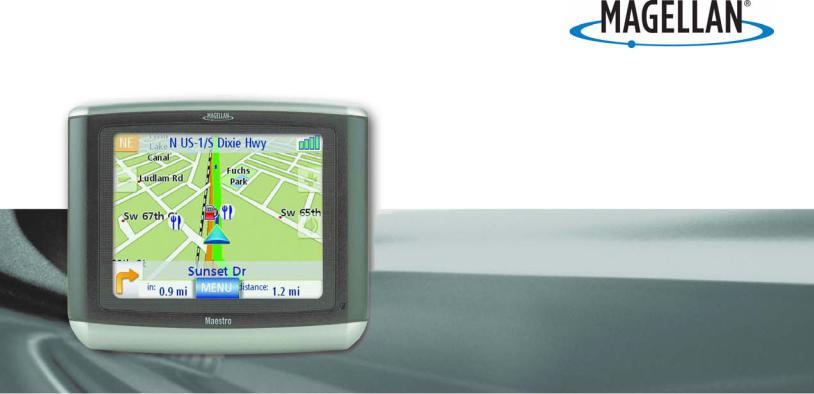
Magellan®
Maestro™
User Manual
Maestro 3050
Maestro 3100
Maestro 3140
Magellan Navigation SAS. - ZAC de la Fleuriaye - BP 60433 44477 Carquefou Cedex - France
IMPORTANT SAFETY WARNINGS
The Magellan Maestro is a vehicle-navigation aid designed to assist you in arriving at your selected destinations. When using the Magellan Maestro, these safety rules must be followed to prevent accidents that can result in injury or death to yourself or others:
•Some countries prohibit mounting any item to your windscreen. Please check the applicable regulations in your country as regards windscreen mounting. Go to www.magellanGPS.com for alternate mounting solutions. An adhesive disk is supplied with the Magellan Maestro for use as an alternative mounting solution to the dashboard.
•When driving, the need to view the display is minimal. Voice prompts will guide you to your destination. The driver should enter data or programme the Magellan Maestro only when the vehicle is stationary. Only a vehicle passenger should enter data or programme the Magellan Maestro while the vehicle is moving.
•It is your responsibility to comply with all traffic laws.
•Every attempt is made to ensure that the database is accurate. However, roadways, points of interest (POIs) and business and service locations may change over time. The database does not include, analyse, process, consider or reflect any of the following: legal restrictions (such as vehicular type, weight, height, width, load and speed restrictions); road slope or grade; bridge height, width, weight or other limits; population density; neighbourhood quality or safety; availability or proximity of police, emergency rescue, medical or other assistance; construction work zones or hazards; road or lane closures; road, traffic or traffic facilities’ safety or condition; weather conditions; pavement characteristics or conditions; special events; traffic congestion. It is your responsibility to disregard any unsafe, hazardous or illegal route suggestions.
•Keep the Magellan Maestro safe from extreme temperature conditions. For example, do not leave it exposed to direct sunlight for an extended period of time.
•Take care when mounting the Magellan Maestro in your vehicle, whether using the windscreen mount or other mount or accessories, that it does not obstruct the driver’s view of the road, interfere with the operation of the vehicle’s safety devices such as air bags, or present a hazard to occupants of the vehicle should the Magellan Maestro be dislodged while driving. You assume the risks associated with damage to your vehicle or vehicle occupants as the result of your choices in mounting the Magellan Maestro.
•Laws in some countries prohibit wearing stereo headphones while operating a motor vehicle. Please check the applicable laws for the country in which you are driving.
•Proceed with caution when listening to music for prolonged periods of time through headphones, as this may lead to hearing loss.
•The battery in the Magellan Maestro is rechargeable and should not be removed. If it ever needs to be replaced, please contact Magellan Technical Support.
About Charging the Magellan Maestro
•Only use the AC adapter (Phihong: PSC2200R-050) approved for your Magellan Maestro. Use of another type of AC adapter can result in malfunction and/or a possible fire hazard due to battery overheating.
•Only use the car charger approved for/supplied with your Magellan Maestro. Use of another type of car charger will result in a malfunction and/or may be hazardous.
•The Magellan Maestro is intended to be supplied with a LISTED Power Unit marked with "LPS", "Limited Power Source" and output rated + 5 V DC/2.0 A".
•Use the USB cable approved for/supplied with your Magellan Maestro.
•For safety reasons, the battery in your Magellan Maestro will stop charging when the ambient temperature is below 0°C (32°F) or above 45°C (113°F).
i
IMPORTANT SAFETY WARNINGS
About the AC Adapter
•Do not use the adapter in a high moisture environment. Never touch the adapter when your hands or feet are wet.
•Allow adequate ventilation around the adapter when using it to operate the device or charging the battery. Do not cover the AC adapter with paper or other objects that will reduce cooling. Do not use the AC adapter while it is inside a carrying case.
•Connect the adapter to a suitable power source. The voltage and earthing requirements are found on the product case and/or packaging.
•Do not use the adapter if the cord becomes damaged.
•Do not attempt to service the Magellan Maestro. There are no serviceable parts inside. Replace the Magellan Maestro if it is damaged or exposed to excess moisture.
About the Battery
•Do not attempt to replace the battery. Please contact Magellan Technical Support for issues related to the battery.
•Use the charger approved for your Magellan Maestro.
ii
IMPORTANT SAFETY WARNINGS
Federal Communication Commission Interference Statement
This equipment has been tested and found to comply with the limits for class B digital devices, in accordance with part 15 of the FCC Rules. These limits are designed to provide reasonable protection against harmful interference in a residential installation. This equipment generates, uses and can radiate radio frequency energy and, if not installed and used in accordance with the instructions, may cause harmful interference to radio communications. However, there is no guarantee that interference will not occur in a particular installation. If this equipment does cause harmful interference to radio or television reception, which can be determined by turning the equipment off and on, the user is encouraged to try to correct the interference by one of the following measures:
•Reorient or relocate the receiving antenna.
•Increase the distance between the equipment and receiver.
•Connect the equipment to an outlet on a different circuit to the one that the receiver is connected to.
•Consult the dealer or an experienced radio/TV technician for help.
This device complies with Part 15 of the FCC Rules. Operation is subject to the following two conditions: (1) This device may not cause harmful interference, and (2) this device must accept any interference received, including interference that may cause undesired operation.
FCC Caution: Any changes or modifications not expressly approved by the party responsible for compliance could void the user's authority to operate this equipment.
IMPORTANT NOTE:
FCC Radiation Exposure Statement:
This equipment complies with FCC radiation exposure limits specified for an uncontrolled environment. End users must follow the specific operating instructions for satisfying RF exposure compliance.
This transmitter must not be co-located or operated in conjunction with any other antenna or transmitter.
In order to maintain compliance with FCC regulations, shielded cables must be used with this equipment. Operation with non-approved equipment or unshielded cables is likely to result in interference to radio and TV reception. The user is advised that changes and modifications made to the equipment without the approval of manufacturer could void the user's authority to operate this equipment.
The Magellan Maestro must be installed and operated at a distance no closer then 8 inches (20 cm) from the user.
This Class B digital apparatus meets all requirements of the Canadian Interference-Causing Equipment Regulations.
iii
IMPORTANT SAFETY WARNINGS
IC statement
Operation is subject to the following two conditions:
1.This device may not cause interference and
2.This device must accept any interference, including interference that may cause undesired operation of the device.
IMPORTANT NOTE:
IC Radiation Exposure Statement:
This equipment complies with IC radiation exposure limits established for an uncontrolled environment. End users must follow the specific operating instructions for satisfying RF exposure compliance.
This transmitter must not be co-located or operated in conjunction with any other antenna or transmitter.
© 2007 Magellan Navigation, Inc. All rights reserved. The Magellan Logo, Magellan, Maestro, Turn it on and go, TrueView, QuickSpell, SmartDetour,and SmartVolume are trademarks of Magellan Navigation, Inc. No part of this user manual may be reproduced or transmitted in any form or by any means, electronic or mechanical, including photocopying and recording, for any purpose other than the purchaser’s personal use, without the prior written permission of Magellan Navigation, Inc.
631477-18 A
iv

Installation Instructions
Installation of the Magellan Maestro is simple and easy. The hardest part will be picking the best location.
Selecting the Location
A few tips on selecting a suitable location.
•Mount the Magellan Maestro in a place where it can be easily seen and will not interfere with your view of the road.
•The Magellan Maestro should be mounted in such a way that the antenna, (located in the top of the receiver), has an unobstructed view of the sky through the windscreen.
•Select whether it will be mounted using the adjustable mount to the windscreen or the supplied adhesive disk. Make sure that you check your local and regional laws before mounting the device on the windscreen. Some countries have laws restricting the mounting of any device on the windscreen.
•If planning to use the adhesive disk, a smooth surface on the dash board will need to be selected. Do not attach the adhesive disk to the windscreen.
•Make sure that the Magellan Maestro or any cabling will not be disturbed if the airbags are activated.
Cleaning the Area
Use the alcohol pad that came with the Magellan Maestro to clean the area on the windscreen or dashboard that has been selected for mounting the Magellan Maestro.
Applying the Adhesive Disk
(Skip if mounting directly onto the windscreen.) Remove the protective tape from the back of the adhesive disk. Apply the disk with the adhesive side towards the dashboard. Maintain pressure on the disk for 5 minutes to allow it to set in place. Allow the disk 24 hours to cure before continuing.
Attach the Adjustable Mount
Line up the two tabs on the adjustable mount with the holes on the back of the Magellan Maestro. Once the adjustable mount is flush with the Magellan Maestro, push the receiver down until it locks in place with the adjustable mount.
Please note that the mounting bracket supplied with the Magellan Maestro may be different to the one shown in this document.
Installation |
1 |
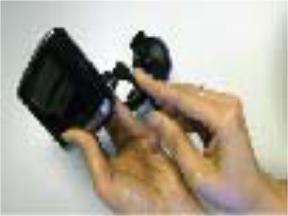
Secure the Mount to the Windshield or Adhesive Disk
Make sure that the lever at the base of the adjustable mount is in the up position. Place the base of the mount firmly over the area of the windscreen to be used or the adhesive disk. Push the lever at the base of the mount all the way down until it snaps into place. Carefully let go of the assembly, making sure that it is securely mounted.
Adjust the Mount for Optimum Viewing
Loosen the adjustment locking knobs and position the Magellan Maestro for optimum viewing. Once set, tighten the locking knobs. (Never attempt to adjust the mount while driving.)
Connecting Power
Plug the end of the cigarette lighter adapter into a 12 VDC cigarette lighter receptacle in the vehicle. Connect the other end to the Magellan Maestro as shown. If there is power at the receptacle, the Magellan Maestro will power on. (Note: some vehicles apply power to the cigarette lighter receptacle only when the ignition is on.)
Security
We recommend that the Magellan Maestro is not left in plain view when unattended as it may attract thieves.
Installation |
2 |

Magellan Maestro
The Magellan Maestro is a vehicle navigation product that uses GPS signals from satellites to calculate your precise location and compute detailed routes. As it knows its position and movement,
it can then overlay this information on detailed maps provided by NAVTEQ® to provide a visual representation of your location.
With the Magellan Maestro you can:
•Store your home address and quickly obtain routing details to your home.
•Create and save addresses in your address book that you can access at any time and obtain routing information to that address.
•Route to an address that you enter using the keypad and Magellan’s QuickSpell feature for easy, error-free entry.
•Route to any point of interest (POI) that has been preloaded into your Magellan Maestro.
•Route to a POI that appears on the map while travelling simply by tapping on the POI icon.
•Route to a town centre.
•Use the trip planner to create a trip with multiple destinations. Handy for business people who need routing information to many destinations.
•Use the POI Near Exit tool that provides you with a list of petrol stations, restaurants, hotels and auto repair shops located near exits you are approaching that you can route to when travelling on a motorway.
•Customise your Magellan Maestro to meet your needs.
The interface for the Magellan Maestro is easy and simple to follow once you understand the basics. You may never need to refer to this manual but if you do we have tried to present it in a form that makes it easy for you to access the function you are trying to use and follow the steps provided.
The Magellan Maestro has a built-in battery, so, in most cases, you will be able to follow these instructions while reading them on your computer screen without plugging it in to the AC power socket. You should note that while indoors you may not get any satellite signals, so your location information may not be updated. However, the power of the SiRFstarIII™ chipset installed in the Magellan Maestro will pick up satellite signals in some very demanding locations, so you may notice the Magellan Maestro computing a position, even indoors.
Magellan Maestro |
3 |
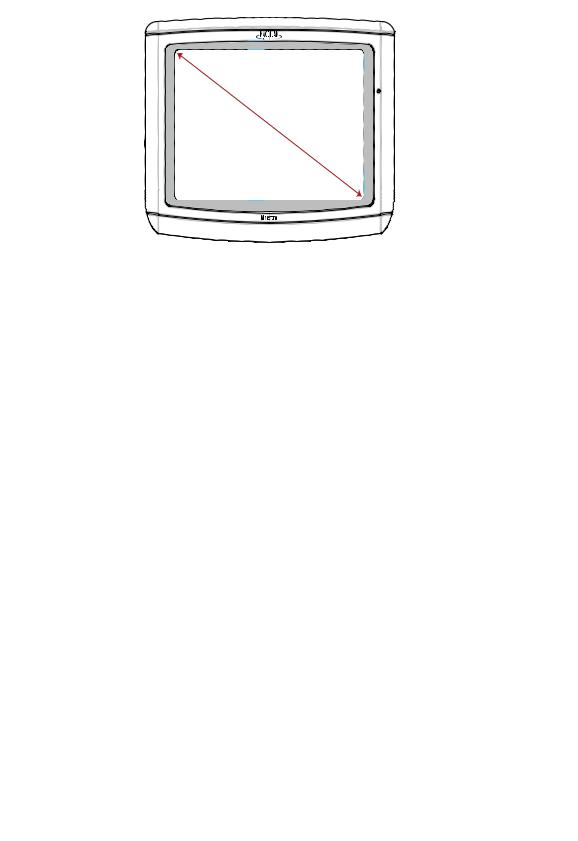
Front View
 A
A
4.3” Display
Side Views
A SD/MMC card slot
BReset
A
C Power on/off
DUSB connector
B |
E Headphone Jack |
|
C |
(3.5mm mini jack) |
E |
FPower input from cigarette lighter
D |
adapter or AC power adapter |
F |
|
(+5 VDC / 2A). |
|
Back View
A
A Speaker
Magellan Maestro |
4 |

Fundamentals
Powering on the Magellan Maestro
The On/Off button is located on the right-hand side of the Magellan Maestro as shown in the Overview chapter.
Turning the Magellan Maestro On
1.Press and hold the On/Off button for 1-2 seconds.
2.Read the Warnings and tap OK.
Turning the Magellan Maestro Off
1.Press and hold the On/Off button for 1-2 seconds.
Selecting Auto Power Off Time
The Magellan Maestro can be set to shut down automatically after a time selected by you. The receiver will turn off after the selected time if; A) the position hasn’t changed and B) the touchscreen hasn’t been pressed.
1.Access the Main Menu.
2.Tap the Next arrow to access the Main Menu Page 2.
3.Tap User Options.
4.Tap System Settings.
5.Tap Power.
6.Select Auto Power Off time; Never, 10 Minutes, 20 Minutes or 30 Minutes.
7.Tap Save.
8.Tap the Back arrow to return to the Main Menu.
Volume
There are two ways to access the volume controls; the first is by tapping the speaker icon on the Map screen and the second is through User Options.
Changing the Volume from the Map Screen.
1.Tap the speaker icon  .
.
2.Tap on the Mute button to mute the volume, or tap inside the volume adjust bar below the Mute button to change the volume levels.
3.Tap Save.
If you have muted the volume, the speaker icon will be displayed with a line through it, indicating it is muted. To unmute the volume, tap the speaker icon again.
Fundamentals |
5 |

Changing the Volume via User Options
1.Access the Main Menu.
2.Tap the Next arrow to access the Main Menu Page 2.
3.Tap User Options.
4.Tap System Settings.
5.Tap Volume.
6.Tap on the Mute button to mute the volume, or tap inside the volume adjust bar below the Mute button to change the volume levels.
7.Tap Save.
Brightness
Accessing the Brightness Control
1.Access the Main Menu.
2.Tap the Next arrow to access the Main Menu Page 2.
3.Tap User Options.
4.Tap System Settings.
5.Tap Brightness.
6.Tap inside the brightness adjust bar to set the desired brightness.
7.Tap Save.
On the Brightness screen there is a checkbox for “On-battery dimming (75%)” When checked, the Magellan Maestro will dim to 75% of the brightness when operating exclusively on battery power. This prolongs the battery life between charges. It can be turned off by tapping on the checkbox.
The Main Menu
The Main Menu screen is the centre for all of the Magellan Maestro’s available functions. The Main Menu consists of two pages with large, easy to access icons.
Accessing the Main Menu
From the Map screen, tap the Menu button. 
From the other screens, tap the Back button.
Fundamentals |
6 |
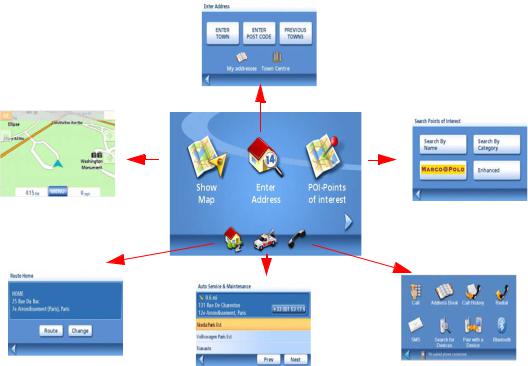
Main Menu - Page 1
Show Map: Displays the map with your current position (if computing a position from the GPS signals) indicated by the blue triangle. See the Map Screen chapter for details.
Enter Address: Displays Enter Address menu. Addresses can be entered by first entering the town, post code, or by selecting a town from a list of towns you have already used as destinations. Also provides access to your address book (my addresses) or to create a route to a town centre. See the chapter on Routing to an Address for details
Points of Interest: Displays the Search Points of Interest menu. Search for POIs by entering the name or by selecting from a list of available categories. POIs that have been created and installed using the POI Editor software (found on the CD-ROM) can be accessed from this menu. For more information on the Search Points of Interest menu, see the Points of Interest chapter.
Home: If you have created a Home address, press the Home button for quick access to routing to your home. If you have not created a Home address, you will be prompted (visually) to do so. See the Home Button chapter for more information.
Roadside Assistance: Displays the Auto-service and Maintenance screen. For more information on this feature, see the Roadside Assistance chapter.
Bluetooth (Maestro 3140 only): Displays the Bluetooth Main Menu screen. For more information on connecting to a mobile phone, see the chapter on Bluetooth.
Fundamentals |
7 |

Main Menu - Page 2
Trip Planner: Opens the Trip Planner menu where you can create, edit, delete, rename or activate a trip.
POI Near Exit: (Accessible only while on a motorway.) Provides a list of restaurants, petrol stations, auto repair shops or hotels near approaching motorway exits. You can select one of the presented POIs and create a route to it.
User Options: Accesses the User Options menu. This menu can be used to access functions used for tailoring the Magellan Maestro to your individual needs.
Home: If you have created a Home address, press the Home button for quick access to routing to your home. If you have not created a Home address, you will be prompted (visually) to do so. See the Home Button chapter for more information.
Roadside Assistance: Displays the Auto-service and Maintenance screen. For more information on this feature, see the Roadside Assistance chapter.
Bluetooth (Maestro 3140 only): Displays the Bluetooth Main Menu screen. For more information on connecting to a mobile phone, see the chapter on Bluetooth
Fundamentals |
8 |
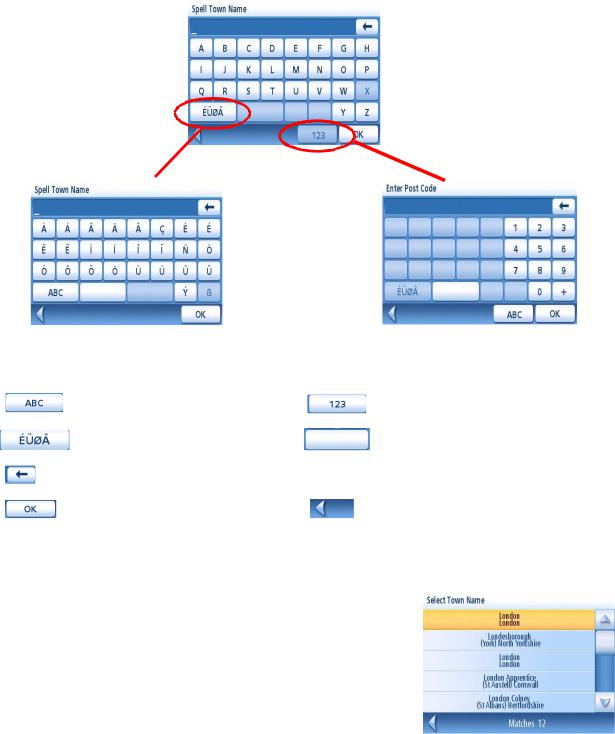
The Keypad
Understanding the keypad while entering an address is an important part of using your Magellan Maestro. The keypad is the most common method for entering data into the Magellan Maestro.
Keypad Overview
Special Keys
Alphabetic Keypad |
Numeric Keypad |
Accented letters Keypad |
Spacebar |
Backspace |
|
Accept |
Cancel |
Selecting From List
After tapping “OK” to accept your input, you may be presented with a list of items found in the database. The sample given here shows the result of tapping “OK” after entering “LOND”. Use the scroll bar to move up and down the list and tap on the desired item in the list to continue.
Fundamentals |
9 |
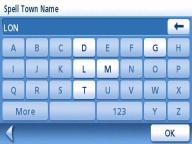
Quickspell
QuickSpell uses information in the database to limit the keys that can be pressed to present only those which correspond with information in the database.
For example, if you are looking for LONDON. As you ‘type’ in the name London, only keys that can spell a town in the database are shown. In the screen to the right, ‘LON “ has been entered. Keys that would not continue to spell a town in the database are greyed out..
This is to enable the town and street names to be entered quickly, without introoducing any errors due to typos.
Notes on Entering Data
If you are having trouble getting the results you expected, here are a few useful tips.
•Make sure that you have spelled the name correctly. If you are unsure of the spelling, just enter a few characters and tap “OK”. A long list of names will be displayed, but you can step through the list and you will probably be able to find the correct spelling.
•When the name of the town has a prefix such as ‘Saint’, ‘The’ ‘Le’, ‘La’ etc. you must enter this prefix in order to obtain the expected result.
•When entering a street name, you can usually enter only one of the significant words in the street name to retrieve it from the database. However, if you are having trouble finding the street you are looking for, we recommend trying to type in its full name.
•The more characters you enter, the smaller the list of entries found will be.
Fundamentals |
10 |
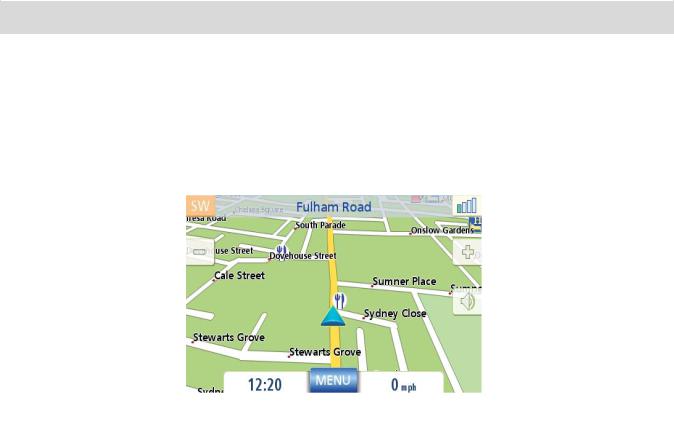
Map Screen
The most commonly used screen will be the Map screen. Whether you are following a route or just travelling around town, the chances are that the Map screen will be displayed. There are two unique modes that the Map screen can be displayed in; normal and routing.
In normal mode, your position is shown on the map along with the time and your speed. As you travel, your position will be updated, giving you a clear view of your position and surrounding streets.
A
B
K
C
J
D
I
E
F G H
Map Screen - Normal Mode
AStreet name currently on.
BDirection indicator. Tap to view the Current Location screen where you can save your position into your Address Book.
CZoom out
DPOI icon. Example shown here is for a restaurant. Tap on the POI icon to create a route to that POI.
Note: If there are multiple POIs in the same area, a list of those POIs will be displayed. Tap on the name in the list to access the routing function.
ECurrent position icon
FTime of day
GMain Menu button. Tap to display the Main Menu.
HCurrent speed of travel
IVolume control. Tap to display the Volume Setting screen where the volume can be adjusted or muted. (If the volume has been muted, tapping this button unmutes the volume without displaying the Volume Setting screen.)
JZoom in
KSatellite Status. All four bars in green denotes the optimal satellite status. Tap to display the GPS Status screen.
Map Screen |
11 |
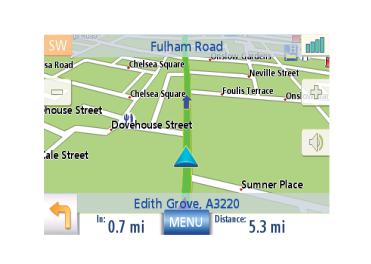
In routing mode additional information is displayed providing detailed information about the route you’ve selected.
|
A |
|
B |
|
N |
|
|
|
C |
|
|
|
|
M |
D |
|
|
|
|
L |
E |
|
K |
F |
|
J |
|
|
|
G |
H |
I |
Map Screen - Routing Mode
AStreet name currently on.
BDirection indicator. Tap to view the Current Location screen where you can save your position into your Address Book.
CZoom out
DPOI icon. Tap on the POI icon to create a route to that POI.
Note: If there are multiple POIs in the same area, a list of those POIs will be displayed. Tap on the name in the list to access the routing function.
ECurrent position icon
FNext segment icon. Tap on the icon to display the List of Directions screen.
GDistance to next segment. Tap to repeat the last voice command.
HMain Menu button. Tap to go to the Main Menu screen. Note that the Main Menu screen is different when there is an active route. See the chapter on Routing for details.
ITap to toggle between the distance remaining to reach the destination and approximately how long it will take to arrive at the destination.
JStreet name for the next segment
KGraphical representation of the route
LVolume control. Tap to display the Volume Setting screen where the volume can be adjusted or muted. (If the volume has been muted, tapping this button unmutes the volume without displaying the Volume Setting screen.)
MZoom in
NSatellite Status. All four bars in green denotes the optimal satellite status. Tap to display the GPS Status screen.
Map Screen |
12 |
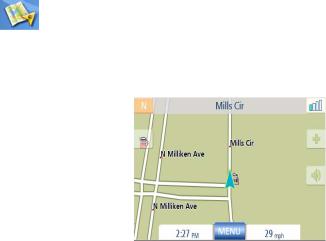
Accessing the Map Screen
1. On the Main Menu, tap Show Map.
2D Mode
The map is normally displayed in 3D mode but you can set the map to 2D mode if so desired. Choose the mode that is most suitable for you.
In 2D mode, you can pan across the map looking for a location to route to or save in your address book.
Setting the Map Modes (2D or 3D)
1.From the Map screen, tap MENU.
2. |
Tap the Next arrow to access page 2 of the |
Map Screen in 2D Mode |
|
Main Menu. |
|
3. |
Tap User Options. |
|
4. |
Tap Map Options. |
|
5. |
Tap 3D Map or 2D Map. |
|
6. |
Tap Save. |
|
Panning on the Map
1.While viewing the Map screen in 2D mode, slide your finger or stylus across the map.
2.The location icon changes to  . (The circle is the crosshairs for a position and the red arrow points to your current location.
. (The circle is the crosshairs for a position and the red arrow points to your current location.
3.To exit panning, tap ESC and the map is returned to your current position.
Saving a Position While Panning
1.Pan the map until the icon crosshairs are over the location you want to save to your address book. (Must be a position that does not have a POI icon displayed.)
2.Tap in the centre of the circle icon. (If nothing happens then you have not zoomed in enough. Tap the zoom in icon and try again.)
3.On the Route To This Address? screen, tap Save.
4.Edit Information:
Tap Edit on the Edit Name line to create a name for this location.
Tap on any of the three (work, home, mobile) phone buttons to enter a phone number. Tap Edit on the Edit Information line to add additional information. (Up to 35 characters can be entered.)
5.If you want to tag this location as one of your favourites, tap on the “Favourite” check box.
6.When the details for this address are acceptable, tap Save.
Map Screen |
13 |
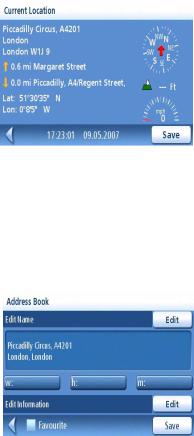
7.If you want to now route to this address tap Route or if you have finished tap Cancel.
8.Tap ESC to exit panning and return the icon to your current position.
Routing to a Panned Position
1.Pan the map until the icon crosshairs are over the location you want to route to.
2.Tap in the centre of the circle icon. (If nothing happens then you have not zoomed in enough. Tap the zoom in icon and try again.)
3.On the Route To This Address? screen, tap Route,
4.Select the desired routing method and tap the Calculate Route  button.
button.
Current Location Screen
This screen is accessed from the Map screen whether you are following a route or just driving around.
The Current Location screen displays approximate address information, the next and previous intersections, as well as your latitude/longitude. To the right is a compass pointing in your direction of travel, the calculated elevation, and speed. The bottom bar displays the current time and date.
Accessing the Current Location Screen
1.From the Map screen, tap the direction icon in the upper left-hand corner.
Saving Your Current Location to Your Address Book
1.Access the Current Location screen.
2.Tap Save
3.Edit Information:
Tap Edit on the Edit Name line to create a name for this location.
Tap on any of the three (work, home, mobile) phone buttons to enter a phone number. Tap Edit on the Edit Information line to add additional information. (Up to 35 characters can be entered.)
Saving Current Location
4.If you want to tag this location as one of your favourites, tap on the “Favourite” check box.
5.When the details for this address are acceptable, tap Save.
Map Screen |
14 |

List of Directions Screen
This screen is accessed from the Map screen and only when following a route. (Note: The List of Directions screen is not available until you begin moving on the route.)
Each line in the list of directions provides details about the segment in the order that they are to be made, with the next segment at the top.
The bottom bar of the List of Directions screen |
|
indicates the distance and time to the next segment as |
List of Directions |
well as the total distance computed for the route. |
|
The List of Directions can be modified if you want to |
|
exclude one of the segments, should you wish to avoid |
|
travelling along one of the listed streets. Instructions |
|
for excluding one of the segments are given in this |
|
chapter. |
|
Accessing the List of Directions screen
1.Tap the segment icon in the lower left-hand corner of the Map screen. This icon is displayed only when you are actively following a route.
Excluding a Segment
This is used for modifying the route, possibly to avoid routing along a particular street.
1.Access the List of Directions.
2.Tap on the item in the list with the street you want to try and avoid.
3.Confirm the exclusion by tapping on Exclude. (Tap the back arrow to cancel.)
4.The Magellan Maestro recalculates the route and displays the List of Directions with the newly computed segments.
Map Screen |
15 |
